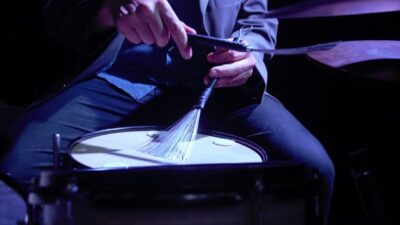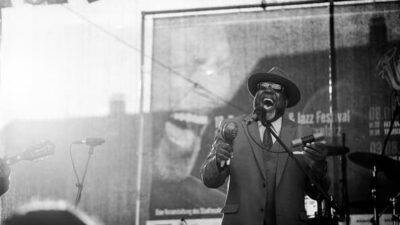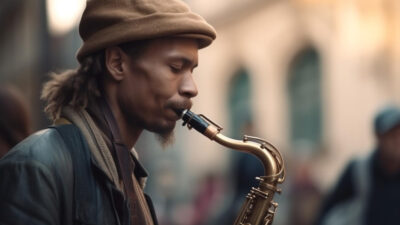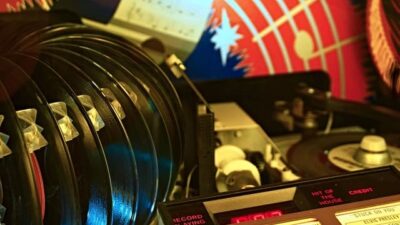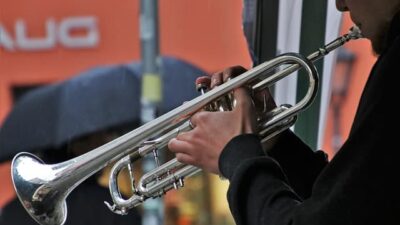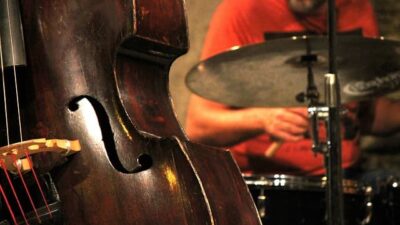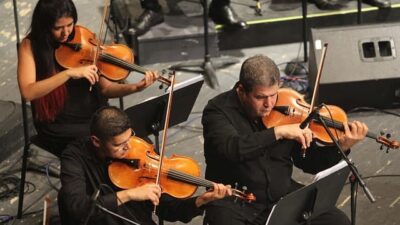October 21 is the birthday of the brightest jazz trumpeter, Dizzy Gillespie. One of the famous jazz orchestra leaders, Count Basie, whose star rose somewhat earlier and in a different era, said, “Gillespie created 75% of modern jazz. Strangely enough, that thought still seems relevant today. At least the jazz mainstream owes its origins to Gillespie. It’s strange to imagine now that an older generation would vehemently criticize the music of Gillespie and his collaborator, the great saxophonist Charlie Parker, claiming it wasn’t jazz. However, a similar story has been repeated many times with different kinds of jazz music. On the occasion of Gillespie’s birthday, we tell you about ten jazz records that we consider to be the best by some criteria. Of course, it’s an impossible task to choose the ten unquestionably best records from a vast ocean. Still, we have tried to present you with records that were either an important event in jazz history or reflected a significant direction.
“The Famous 1938 Carnegie Hall Jazz Concert” (1950, Columbia) Benny Goodman
A recording of a historic 1938 concert by one of the premier (at the time so-and-so premier) jazz orchestras in the United States. This concert actually marked the success of jazz in the so-called big time: the first time a jazz band performed at Carnegie Hall, the citadel of “serious music.” The so-called swing era, when young American audiences suddenly embraced the hot new music, began about two and a half years before the Carnegie Hall concert, and it was the Benny Goodman Orchestra that was lucky enough to be the first on that wave. Benny Goodman was not only an outstanding musician and a talented bandleader: he also played an educational role in the history of jazz (his bands’ broadcasts on the radio were essential in popularizing jazz bands) and a social one – Goodman was the first bandleader who brought together “white” and “black” musicians. From this recording you can get an idea of jazz in general at the time: the musicians play archaic jazz from 1918, works for large ensemble and for quartet (Benny Goodman for clarinet, Teddy Wilson for piano, Lionel Hampton for vibraphone, Gene Krupa for drums). Fast tempos with firing percussion accents, swirling brass unisons, witty solos – swing in all its glory.
“Djangology (2005, Bluebird) Django Reinhardt
The great French guitarist of Belgian origin Django Reinhardt did not see any of his recordings on a long-playing record during his lifetime. The performances on this compilation were made by the guitarist in 1949 during a tour of Italy with his long-term partner, the French violinist Stéphane Grappelli, accompanied by the Italian rhythm section. These concerts turned out to be Reinhardt and Grappelli’s last collaboration. The recording is not typical: from 1934 until the beginning of the war the musicians collaborated primarily in the Quintette du Hot Club de France, formed on the initiative of the Paris Society of Jazz Lovers, and that quintet consisted of three guitarists (including Django himself and his brother Joseph), a violinist and a double bassist. In Italy, however, Reinhardt and Grappelli are accompanied by a piano trio. Thus, to the traditional sound of jazz manouche, as the style created by Reinhardt is called (manouche is the self-name of the gypsies who came to France through Germany and other more northern European countries), the piano and, most importantly, the drums are added. But the rhythm section plays extremely delicately, so that at times it seems as if we are listening to a duet recording. The nuances of the duo’s playing are presented with all the finesse.
Reinhardt, a subtle musician who became an outstanding virtuoso despite an injury (two fingers on his left hand were paralyzed in a fire in his youth), was almost the only European musician who emerged in the prewar era and who managed to become an important figure for American jazz. Many American jazz guitarists were influenced by him. In Woody Allen’s “Sweet and Nasty,” the fictional guitarist Emmett Ray says time and again, “There’s no one like me in guitar playing… Except that gypsy in France.”
“Afro” (1954, Norgran) by Dizzy Gillespie
The jubilee could have been presented with another recording (in fact, each of the ten accompanying texts published here could have begun with such a turn), more characterizing him as the founder of bebop and the progenitor of the modern jazz mainstream. For example, the filigree album Bird and Diz, Gillespie’s gripping dialogue with Charlie Parker, or the legendary concert Jazz at Massey Hall, where the same pair, along with pianist Bud Powell, double bassist Charles Mingus, and drummer Max Roach demonstrate a stunning flight of musical imagination and revelation of freedom in real time, would be suitable for this role. If some figures of the modern mainstream can sometimes be reproached for an excessive adherence to tried-and-true schemes and an emphasis on technique at the expense of art, Gillespie and his comrades on these recordings, by contrast, prove that jazz is a living life, which even within a given framework will flow according to laws known to it alone. But I want to mention another side of Gillespie’s work. He was one of the first who could easily combine jazz and Latin rhythms (today Latin jazz is one of the main directions of modern improvised music; in 2012, there was a huge scandal in the American music industry, when the Grammy’s lost the nomination “Best Latin Jazz Album”, and the next year the nomination returned to the system). The album is divided into two parts. The first four numbers are recorded by a large cast, with arrangements by Cuban composer Chico O’Farrill. The last three numbers are played by a much more modest lineup, but their sound is not much less intense due to the fact that they, like the first four, feature an extended (Cuban) percussion section. “Manteca Theme”, “A Night in Tunisia”, “Con Alma” and even “Caravan”, composed eighteen years before this recording, sound here like joyful anthems of a lush, rich and colorful life and represent the best examples of Afro-Cuban music.
“Lady Sings the Blues” (1956, Clef) by Billie Holiday
It’s not easy to choose the best recording of this amazing singer. Lady in Satin, the last record released during Billie Holiday’s lifetime, is very different from others in her discography: here she is assisted by a big orchestra conducted by Ray Ellis with an abundance of strings. The overall sound is soulful but salon-like, and only the singer’s inimitable voice seems to fall out of all this sterility and, at the same time, seem to justify its existence. By this time, Holiday’s voice had changed a lot – weakened, husky, more trembling – and yet it was her voice, incomparable, out of place, mesmerizing with its natural curvature, inarticulosity, strangeness. “Lady in Satin” showed how Billie Holiday remains herself in any entourage. But since we’re talking about jazz records, it’s probably more appropriate to suggest a recording of Holiday accompanied by a jazz ensemble. Especially since some of the accompanists here deserve special mention: pianist Wynton Kelly, guitarists Kenny Burrell and Barney Kessell, drummer Chico Hamilton. The most important tracks on the album are probably the first, which gives the album its title and immediately plunges us into Holiday’s usual state of ironic doom, a sort of borderline state between major and minor, and the piercing “Strange Fruit,” dedicated to lynching victims.
“Kind of Blue” (1959, Columbia) by Miles Davis
Not only one of the most famous works by the great trumpeter Miles Davis, but also one of the most popular records in jazz history. It went four times platinum about a decade ago, with at least four million copies sold. This is especially interesting because jazz is often associated with something upbeat, virtuosic, and impetuous, while on “Kind of Blue” we hear music that is thoughtful, unhurried, and in some places even quite drawn-out. Nevertheless, it breathes the same freedom, the same life as the more energetic jazz recordings, with improvisation, unevenness, and real feeling. The album featured saxophonists Cannonball Edderly and John Coltrane and pianist Bill Evans — the latter two’s serious solo careers began just after the record’s release. “Kind of Blue” is considered one of the first opuses of so-called modal jazz, in which the musical basis is not changes in harmonies but sound combinations within a fret, so that basic moves and improvisation can be built virtually on a single chord with slight offsets. It turns out that by using such a formally limited set of tools and rather sparingly improvising (listen, for example, to Coltrane’s solo in “Blue in Green”), an incredible richness of nuance can be achieved.
In 2014 there was a scandal in the jazz world: the subversives from the ensemble with the terrible name Mostly Other People Do the Killing recorded an album on which they reproduced all the parts of “Kind of Blue” one-to-one, that is, they based one of the main works of jazz on something that essentially contradicts the very spirit of jazz.
“A Love Supreme” (1965, Impulse!) by John Coltrane
One of the recognized pinnacles in the work of the great saxophonist and in jazz in general. In 1962, the so-called John Coltrane Classic Quartet was formed – with McCoy Tyner on piano, Jimmy Harrison on double bass and Alvin Jones on drums. By this point, Coltrane had already been accused of playing “anti-jazz”: before forming the “classical quartet”, the saxophonist was actively developing ideas of modal jazz (see the chapter on “Kind of Blue”), and was also inspired by the principles laid down in Indian ragas and the emerging free jazz, i.e. jazz free from harmonic and rhythmic frameworks. In other words, Coltrane was moving decisively away from familiar jazz schemes; his ensemble could, for example, improvise for long periods while sitting on a single harmony. With the new quartet, the saxophonist temporarily returns to a soft, traditional sound, built on regular harmony changes, to short ballads – though the ensemble’s activities are not limited to this, and at concerts the quartet sometimes plays violently and again relying on harmonies. With this creative baggage and, as Coltrane put it, “a balanced repertoire,” the ensemble approached the creation of a four-part suite about the love of God. The first movement, Acknowledgement, is based primarily on a four-note sequence, first played by the double bass and later by the saxophone, and on these same notes Coltrane puts the words “a love supreme,” which gave the suite its name; the solo in the middle of the movement at times looks most like a repetition with variations of an almost conversational phrase. The second movement, “Resolution,” is closest to a jazz piece with a coherent theme and its development through piano and saxophone solos – and it is based on modal jazz principles. The third and fourth pieces in some editions are on the same track, even though they are quite different. In “Pursuance,” each member of the quartet is given the opportunity to show off, the pianist and especially the drummer and saxophone player going to all sorts of trouble until they are interrupted by a more subdued double bass monologue. Finally, “Psalm” is a unique experience of interpreting a text through music: accompanied by the others, again playing one harmony, Coltrane performs a psalm of his own composition on saxophone without saying the words, each note roughly corresponding to one syllable of the text, and one can tell by the intonation and pauses approximately where each word begins.
Following this landmark work, the quartet made a number of recordings during 1965 on which it sounded much freer, until Coltrane, obsessed with radical new ideas and mastering radical ways of sounding, began to expand the lineup, resulting in the departure of pianist Tyner and drummer Jones. Coltrane’s music became very different.
“Light as a Feather” (1973, Polydor) by Chick Corea and Return to Forever
Keyboardist Chick Corea has led and leads ensembles of all sorts. There are some that sound more electric and fusion, and some more acoustic, more inheriting traditional jazz. The ensemble Return to Forever has sounded quite differently in different periods. The most famous is the line-up with Al Di Meola on guitar – the records of the mid-1970s are considered classics of fusion and/or jazz-rock. The first lineup of Return to Forever is quite different. There is no guitar at all, the main solo instrument, apart from the electric piano, is the flute or (less frequently) Joe Farrell’s saxophone. The most important component is the Brazilian flavor brought by a married couple: singer Flora Purim and percussionist Airto Moreira. The album’s sound is light and fluttering (the ensemble’s other regular member, Stanley Clarke, hasn’t yet switched from double bass to bass). Purim’s voice, with its rich range, fits the overall fabric just right. Enveloping in the song that gives the album its name, winding up in “You’re Everything” (where the record starts), as if fractured but leading to the only possible point in “500 Miles High”. But it is even more appropriate in the numbers without lyrics – “Captain Marvel” and especially the great “Spain”, where it is already perceived simply as one of the instruments, without which the perfect sound of this work seems impossible (though Coria repeatedly performed it with other compositions as an instrumental). “Spain” begins with a thoughtful, heartfelt quote from Spanish composer Joaquin Rodrigo’s Aranjuez Concerto for Guitar and Orchestra, and suddenly a keyboard cascade comes from somewhere, and then the voice comes in, and you are swept up in this flow, and you will probably never forget this music.
“The Köln Concert” (1975, ECM) by Keith Jarrett
Pianist Keith Jarrett is one of the most versatile and controversial figures in jazz history. He is a musician who has tried to immerse himself not only in jazz, but also in academic music (his repertoire includes Bach’s “Well-Tempered Clavier” and Shostakovich’s “24 Preludes and Fugues”). A composer who composed for academic ensembles. Multi-instrumentalist (in addition to his main instrument, the piano, Jarrett sometimes plays drums, guitars, organ, and wind instruments). On one of his earliest albums, he plays (and sings!) something more akin to folk-rock than anything else. And a few years ago he released records that could be characterized as either fusion or instrumental California rock, with elements of ethnic music as well. In recent years Jarrett’s concert activities have focused entirely on two formats – a trio with double bassist Gary Peacock and drummer Jack DeJohnette and solo performances. With the trio, Jarrett was either doing total improvisation or performing jazz standards, that is, pieces that have been consistently in the repertoire of most jazz musicians for decades. But for the past three years, Jarrett has not performed with a trio either. The pianist’s recitals are something of a paradox in jazz: Jarrett only performs in large concert halls and requires the audience to be completely silent. At the same time he behaves defiantly during his performance, squirming and making noises that sound like a groan or a squeak. Jarrett’s solo performances are almost exclusively improvisational, and often (as in the Cologne Concerto) meditative, around two chords. This recording became the most popular solo album in jazz history and the most popular piano album in the history of the recording industry. Which is especially surprising when you consider that Jarrett gave the concert late in the evening, terribly tired, suffering from back pain, and almost refused to perform when he learned that he had been mistakenly assigned an old instrument with a bad sound for the concert. Nevertheless, as you can hear, the pianist did everything possible to squeeze the right sound out of the unfortunate piano.
And Jarrett’s new solo albums continue to be released, with a four-disc edition with recordings of his 1996 concerts in Italy awaiting us in November.
“Masada: Zayin” (1996, DIW) John Zorn
John Zorn, saxophonist, composer, ideologue and guru of Downtown, New York’s avant-garde scene, has written (and continues to write) all kinds of music. For large and small academic ensembles, for piano trio, for string trio, for guitar solo, for female vocal ensemble, for (conventionally) a rock band capable of playing anything in the world (indeed, all musicians who fall into Zorn’s orbit seem to have this quality). His musical interests range from surf to noise, from ragtime to grindcore. Sometimes he and the musicians who work with him can
He is also very good at the same time, as if he were from previous eras. And sometimes he has works that come as if from previous eras – he has such a good feel for all kinds of directions and intonations. In the music of the Masada Quartet, Zorn combines the principles of free jazz (see the chapter on “A Love Supreme”) in the spirit of one of the founders of the genre, Ornette Coleman, with elements of melodies and harmonies from the music of Eastern European Jews.
This “radical Jewish culture,” as Zorn calls it, has proven to be one of the richest sources in his work. The ensemble Masada, in which trumpeter Dave Douglas, double bassist Greg Cohen and drummer Joey Baron played with him, has been gone for more than fifteen years, and Zorn continues to compose for a wide variety of ensembles and musicians. The 32nd (!) volume of the second cycle of “Masada songs” has just been released, and next year we are promised a box of 11 discs with compositions from the third cycle.
“Tuesday Wonderland” (2006, ACT Music) by Esbjörn Svensson Trio
The last studio album by the distinguished Swedish trio, released during the lifetime of its leader, pianist Esbjörn Svensson, who died at the age of 45 while scuba diving. (By the way, the trio’s last concert was in Moscow.) Svensson died in his heyday (there were enough unreleased studio recordings for two more albums released after his death), and Tuesday Wonderland demonstrates this vividly. Svensson, however, had already proved that a piano trio, formally indistinguishable from traditional jazz ensembles of the same composition, can successfully perform in rock clubs and stadiums, appear with their music videos on MTV, appear in the charts on a par with pop artists. Perhaps one of the main reasons for the trio’s success was Svensson’s ability to compose melodically simple and catchy pieces using elements of different musical languages. For Svensson, jazz was only one component in the composition of music, and, of course, the music of the trio (and many other ensembles that followed in his footsteps) became yet another reason to discuss where jazz ends. Indeed, some works of e.s.t. can be safely called rock compositions, others have obvious ambient element, and, for example, “Fading Maid Praeludium”, which opens the album “Tuesday Wonderland”, begins as a work of the Romantic era, and then turns into a metal slow drum. In addition, the trio members abundantly used various ways to enrich the sound, up to and including electronic gadgets. And yet the true jazz is present in Svensson’s music, whether explicitly or invisibly, as a spirit of freedom, lightness, a tendency to change – and sometimes even as a swing, especially in improvisation.
After the death of the pianist, his comrades-in-arms, double bassist Dan Berglund and drummer Magnus Eström, each founded their own ensemble, with their own handwriting and language.


